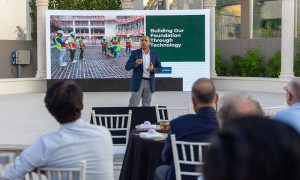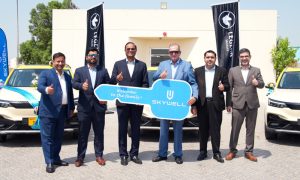The kit seller turned web builder
Indoogoo founder Mark Turner talks Middle East kit trading

You may have heard of Indoogoo, a new platform for selling used equipment as well as rentals. It allows sellers and buyers to build up a network of contacts, much the same way as on a site such as LinkedIn, though with its use as a tool for equipment sellers the contact lists stay secret. Founder and CEO Mark Turner is based in the UAE and has a long history selling used cranes in the Middle East and further afield. He shared with www.constructionmachineryme.com some of the highlights of his trading career.
Construction Machinery ME: What’s your history selling used equipment in the Middle East, and what’s was the biggest ever sale?
Mark Turner: I worked as a trader and broker on and off for 20 years in the Middle East, but it was only the last seven years up until October 2013 that I ran my own trading business, HEAVYKIT. The most expensive piece of equipment I ever brokered was a Liebherr LR1750 Crawler crane for Euros 5.5 million. It was an incredible deal which took six months to finish and which took me on an incredible adventure to Mongolia, only to find I’d been taken to inspect the wrong crane! It was a fantastic deal though with both the buyer and seller very happy. The most expensive piece of equipment I ever ‘traded’ was a Manitowoc 4100 S2 Crawler crane, which I bought with a silent partner, refurbished and sold for $1.1 million. The buyer was extremely happy as they were basically buying a brand new crane and a machine they needed that just couldn’t be found at the time in the market.
CMME: Is there one sale where you let a piece go too cheaply? What was the lesson for you from this sale?
MT: That’s a tough question. I brokered a crane to India a few years ago: the customers inspected the crane, everything was great, the price was agreed, everyone was happy. Then the customer created a huge drama in order to ‘chip’ down the price. I was in a terrible position and ended up having to negotiate the price down considerably with the seller, while at the same time trying to maintain some sense of value on the deal and also my own professional reputation. The seller agreed on condition that I waived my commission – so for the sake of my reputation with the seller that’s what I did. I made nothing on the deal. Both buyer and seller were happy.
Two months later (while I was on holiday), the buyer phoned me up in a panic and asked for help – he’d loaded the crane on to a ship, but in an effort to save on freight had ignored the need for proper sea fastenings. It was monsoon season and while sailing to India the crane, a 200 tonne Demag ,was picked up by a rogue wave and literally thrown over the side never to be seen again! The buyer wanted my help in dealing with his insurers. The lesson for me: to hold on to your price with full confidence that you know it’s a good price for a good machine. What was the lesson for the buyer? You probably need to ask him.
CMME: What were some of the biggest changes you saw in the used crane industry during that time?
MT: The biggest change I saw was the move really from friction rigs to hydraulic machines. Following that the age restrictions on equipment going in to certain job sites in certain countries and seeing the market fall out of the bottom of the older machines. The 4100 S2 that I sold in 2007 just before the crash for $1.1 million, which granted was an exceptional deal, would struggle to reach $300,000 today, because of the age restrictions, despite the fact that so many end-users still love these machines because they are simple to use and just keep going and going if you look after them.
The improvements in technology and quality from manufacturer’s is amazing, from the use of GPS technology to collate ‘Big Data’ allowing fleet managers so much control over their fleets to Manitowoc’s incredible VPC technology and Terex’s incredible boom booster kit, the list goes on to continual improvements in safety and durability. The fact is, if we’re honest there aren’t really any ‘bad’ machines being manufactured these days are there?
CMME: Did you see much of a change in your time with entry into the Middle East of cranes from China? Did that change market dynamics?
MT: Yes, it was a huge impact. The market, seemingly overnight was flooded with Chinese products, but it was a strange time. A lot of fleet owners were buying these machines purely on price and then retro-fitting them with Western parts. There were loads of stories in the market of break-downs and accidents. There was also a flood of the so called ‘cut and paste’ machines, where traders for example were going over to Japan, buying scrap cranes, importing them back to China, rebuilding the cranes with inferior parts and materials, keeping the original serial number plates on them and passing them on as ‘original’ used machines. Not a bad idea when you consider that – for example – an original five-year-old 25 tonne Tadano Truck crane was then comfortably selling for about $250,000! So you could see why they were doing it and to be honest they did it really well. But after a while there were so many of them in the market place, they became very easy to spot. That being said you almost felt sorry telling the poor guy that had bought it that it was worth basically nothing and not the $200,000 he was dreaming of.
That being all said and done, they were starting off and their overall strategy of flooding the market paid dividends. Now, some of the machines coming out of China are amazing and still offer a great price break with good quality.
CMME: You’ve launched Indoogoo, a new online market place described as being like a mix between LinkedIn and Amazon. Was this to fill a gap in the market?
MT: Indoogoo really started off as a solution to my own problems. At the time I had the idea of Indoogoo I was desperate for a sale. None of my regular customers were buying machines, I had 500 contacts on Linkedin and had no clear answer of finding new buyers for about 10 cranes I had on my books. I just thought it would be great if I could have something like Linkedin, which gave me the ability to exponentially grow my trading network while advertising my cranes at the same time. As the idea started to gain momentum and take shape, I realized that this was something that other people might benefit from and understood in fact that it wasn’t so much a gap that I was trying to fill but that it was more about creating a platform that presented some sensible solutions in this industry.
CMME: Sales of used equipment online is growing, but many buyers still want to ‘get their hands dirty’ and inspect before they buy. Do you think this is changing – are people comfortable buying kit off photos and the seller’s description?
MT: I don’t think that will ever change and and nor should it. In order to fully understand what you’re buying you really do need to go and inspect the machine yourself or have a professional inspector do that for you. Getting ‘your hands dirty’ is all part of the business and to be honest, for me it was always the fun part! The one thing I missed when I first closed down my trading business was actually going out to inspect a crane on a job site somewhere. Climbing over it, crawling underneath it. I’m not a mechanic but over the years there are certain things you know to look for – the basics. That being said, if there is a very clear value proposition in the price and condition of a machine and you’re experienced enough to know that it’s worth taking a punt on, then for sure more people are willing to buy basically ‘off spec’ from a website, but they’ll be ready for a hit and will most likely have a reserve held back to take care of any repairs that may be needed. The fact that Indoogoo is a social network first means that both buyers and sellers have the opportunity to meet and interact immediately offering the best of both worlds. Regardless of how good the photos are, getting in the car or on the plane to inspect will always be the best way to go.

























